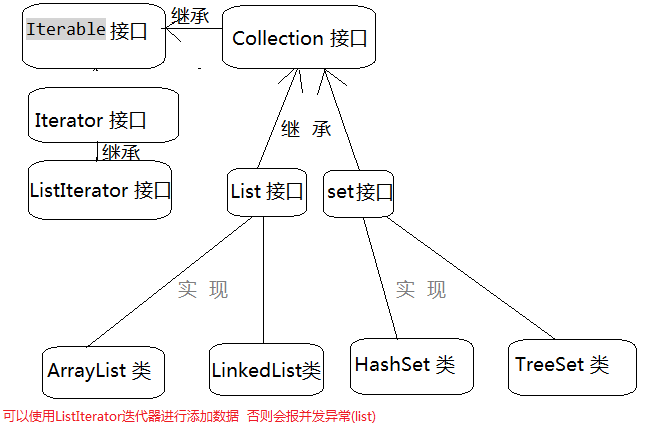Collection 接口

方法实现
boolean add(Object o);//添加
boolean remove(Object o);//移除
修改方法 让实现类自己去实现修改元素
判断功能
boolean contains(Object o) 是否包含元素
boolean isEmpty() 是否为空
转换功能
Object[] toArray();
增强for进行遍历 获取集合中的元素
public class CollectionTest01 {
public static void main(String[] args) {
Collection<String> c = new ArrayList<String>();
/*
* 增删改查
*/
// 添加
c.add("hello");
c.add("world");
c.add("java");
System.out.println(c.contains("java"));
System.out.println(c.isEmpty());
System.out.println(c);
// 移除
c.remove("java");
System.out.println(c);
// 遍历
for (String st : c) {
System.out.println(st);
}
System.out.println("--------");
Object[] array = c.toArray();
for (int i = 0; i < array.length; i++) {
System.out.println(array[i]);
}
}
}
输出结果:
true false [hello, world, java] [hello, world] hello world -------- hello world
List 继承于 Collection 接口
//私有方法
ListIterator ListIterator() 解决了Iterator迭代器的添加并发性
E get(int index) 获取集合的元素
E set(int index,E element) 修改指定位置的所以
int indexOf(Object o) 查寻元素的索引位置
public class ListTest {
public static void main(String[] args) {
List<String> list=new ArrayList<String>();
list.add("hello");
list.add("world");
list.add("java");
list.add(1, "Hi");//按照索引添加
System.out.println(list);
System.out.println("-------");
//获取元素
System.out.println(list.get(0));
System.out.println("-------");
//修改元素
list.set(0, "Hi");
System.out.println(list.get(0));
System.out.println("-------");
int i = list.indexOf("java");
System.out.println("java的索引位置"+i);
}
}
ArrayList
list接口的实现类 实现了所有的方法
构造方法
ArrayList() 构造一个初始容量为 10 的空列表。 如果超过10个 会自动扩容
ArrayList(int initialCapacity) 构造一个具有指定初始容量的空列表。
底层是个数组
增
boolean add(Object o);
void add(int index,E element)
删
E remove(int index);
boolean remove(Object o);
改
E set(int index,E element)
查
E get(E Element)
public class ArrayListTest {
public static void main(String[] args) {
ArrayList<String> array=new ArrayList<String>();
array.add("hello");
array.add("hello");
array.add("hello");
array.add("hello");
array.add(0,"java");//按照索引插入
System.out.println(array);
System.out.println("---");
array.remove(0);//按照索引移除
System.out.println(array.remove("hello"));//按照元素移除
System.out.println(array);
System.out.println("------");
array.set(0, "PHP");//按照索引修改
System.out.println(array);
System.out.println("----");
System.out.println(array.get(0));//按照索引获取元素
}
}
输出结果: [java, hello, hello, hello, hello] --- true [hello, hello, hello] ------ [PHP, hello, hello] ---- PHP
LinkedList
底层是个链表格式
增
boolean add(Object o);
void addFrist(Object o);//添加到第一位
void addLast();//添加到最后一位
删
E removeFrist();//移除第一位
E removeLast();//移除最后一位
E remove();//默认移除开头位
void remove(int index);//移除指定索引的元素
boolean remove(Object o);//移除指定元素
改
E set(int index,E element)//修改指定索引的元素
查
E get(int index);//获取指定索引的元素
E getFrist();//获取第一位索引元素
E getLast();//获取最后一位的索引元素
public class LinkedListTest {
public static void main(String[] args) {
LinkedList<String> list=new LinkedList<String>();
list.add("2");
list.add("3");
list.add("4");
list.add("5");
list.add("6");
list.add("7");
list.add("8");
list.add("9");
list.addFirst("1");
list.addLast("10");
System.out.println(list);
System.out.println("---");
list.remove();//默认移除索引第一位
System.out.println(list);
System.out.println("---");
list.remove(0);//移除指定位置的索引
System.out.println(list);
System.out.println("---");
list.removeFirst();//移除第一位索引元素
list.removeLast();//移除最后一位索引元素
System.out.println(list);
System.out.println("------");
System.out.println(list.getFirst());//获取第一位元素
System.out.println(list.getLast());//获取最后一位元素
System.out.println(list.get(0));//获取指定所以索引的元素
System.out.println("---");
list.set(0, "0");
System.out.println(list);
}
}
输出结果: [1, 2, 3, 4, 5, 6, 7, 8, 9, 10] --- [2, 3, 4, 5, 6, 7, 8, 9, 10] --- [3, 4, 5, 6, 7, 8, 9, 10] --- [4, 5, 6, 7, 8, 9] ------ 4 9 4 --- [0, 5, 6, 7, 8, 9]
iterator迭代器
作用:遍历集合
Iterator接口---------ListIterator接口
(所有集合做为它的实现类) (只能被实现List接口的实现类使用)
Iterator 在遍历的过程中不能进行添加数据 否则会报异常 但是可以移除元素(使用遍历器进行移除,在移除的过程中会修改器预期值)
( 当方法检测到对象的并发修改,但不允许这种修改时,抛出此异常。Exception in thread "main" java.util.ConcurrentModificationException)
public class ArrayListTest {
public static void main(String[] args) {
ArrayList<String> array = new ArrayList<String>();
array.add("hello");
array.add("hello");
array.add("java");
array.add("hello");
array.add("hello");
Iterator<String> it = array.iterator();/Iterator遍历器没有添加功能
while (it.hasNext()) {
if (it.next().equals("java")) {
array.add("PHP");
}
}
}
}
并发异常:预期值与实际值不相符。所以产生异常。
ListIterator 在迭代的过程可以进行添加操作(解决了并发性异常)
public class ArrayListTest {
public static void main(String[] args) {
ArrayList<String> array = new ArrayList<String>();
array.add("hello");
array.add("hello");
array.add("java");
array.add("hello");
array.add("hello");
ListIterator<String> it = array.listIterator();
while (it.hasNext()) {
if (it.next().equals("java")) {
it.add("PHP");
}
}
for (String str : array) {
System.out.println(str);
}
}
}
输出结果: hello hello java PHP hello hello
增强for
for(初始化;判断条件语句;控制条件语句){
循环体;
}
for(类型 变量:集合对象){
循环体;
}
public class ArrayListTest {
public static void main(String[] args) {
ArrayList<String> array = new ArrayList<String>();
array.add("hello");
array.add("hello");
array.add("java");
array.add("hello");
array.add("hello");
for (String str : array) {
System.out.println(str);
}
}
}
输出结果: hello hello java hello hello